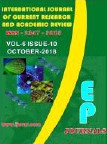Abstract Volume:6 Issue-10 Year-2018 Original Research Articles
 |
Online ISSN : 2347 - 3215 Issues : 12 per year Publisher : Excellent Publishers Email : editorijcret@gmail.com |
2Development of Livestock and Animal Welfare Institution of Puntland - Somalia
In Ethiopia, most of the camel milk production is accounted by the traditional milk processing system and unhygienic handling that are generally poor in processing capacity, causing high product loss and risky for public consumption. A cross-sectional study was carried out in Ab’ala woreda of Afar national regional state from August to November 2017 with the objective of assessing the bacteriological quality, handling practice and major bacterial pathogens of camel milk. The study methodology employed was questionnaire survey and observational study for handling practice and bacteriological count and isolation and detection of major pathogenic bacteria from raw camel milk. Thirty (30) purposively selected camel herders were interviewed for the survey-based study of milk handling practices and forty raw milk samples were aseptically collected and tested for bacteriological load analysis and isolation of major bacteria. The overall average total bacterial count ranged from 2.3x109 to 1.65x109 cfu/ml with a mean value of 56.20x109 milk samples directly from the teat and 92.25x109cfu/ml milk samples from equipment (buckets) at farm level. Results showed very significant differences in total plate counts (P < 0.05) between the two milk collection points. The total bacterial count of the milk samples was high in buckets when compared to the samples taken from the teat directly. In this study milking system and handling practices like udder cleaning, hand washing before milking and cleaning vessels was in poor sanitary condition. No statistically significant variation was observed in coliform counts in milk samples collected from the teat compared to milk samples from the equipment used to milk camels. Meanwhile, coliform counts demonstrated a limited increase (P > 0.05) from udder (teat) to equipment (bucket) level. High coliform count in milk indicates fecal contamination of milk. Milk was produced and handled in unhygienic condition. The results of the current study indicated that the camel milk produced and handling in the study area can generally be considered as substandard in quality for consumption unless pasteurized. Therefore, this risk assessment study with similar different studies reported from different regions in Ethiopia might provide a basis for the establishment of national milk quality standards in Ethiopia.
How to cite this article:
Bashir Abdifatah Mohamed and Ahmed Ali Farah. 2018. Assessment of Bacteriological Quality Major Bacterial Pathogens and Handling Practices of Raw Camel Milk in Ab’ala Woreda of Afar National Regional State, Ethiopia.Int.J.Curr.Res.Aca.Rev. 6(10): 71-86doi: https://doi.org/10.20546/ijcrar.2018.610.008



Quick Navigation
- Print Article
- Full Text PDF
- How to Cite this Article
- on Google
- on Google Scholor
- Citation Alert By Google Scholar
